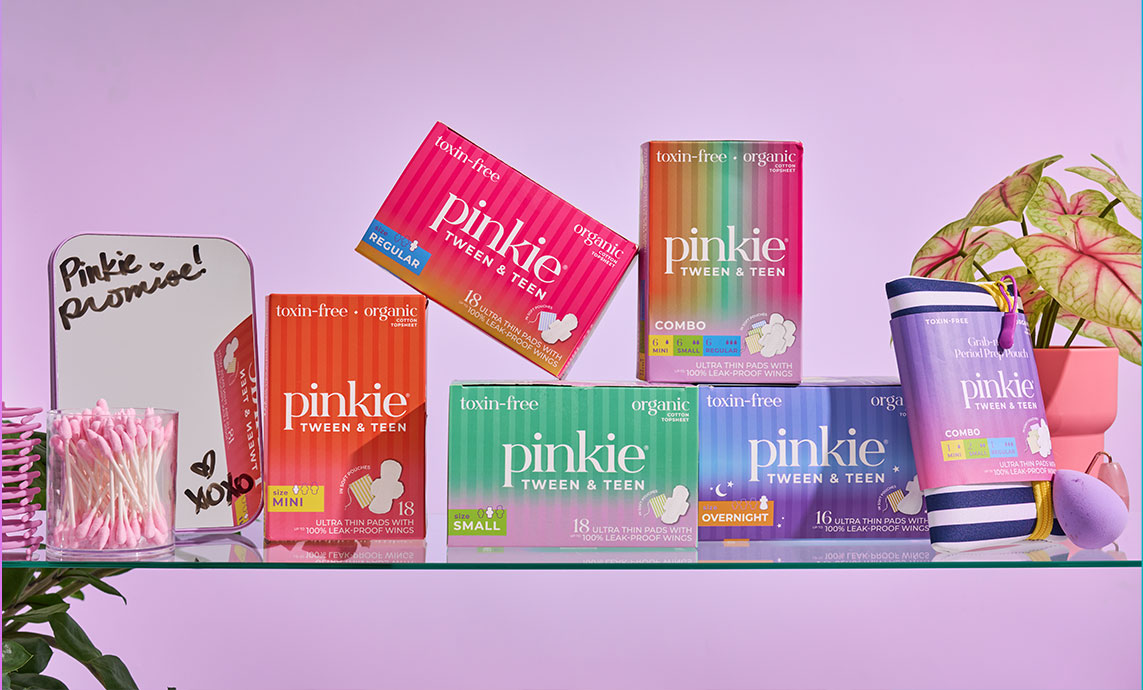Demystify menstrual periods with this quick guide to everything you need to know about what a period is.
The more you learn about this naturally monthly cycle that most women go through, the less scary it becomes. In this blog, we’ll walk you through all the essential details you ought to know about your period.
We’ll cover:
- What is a menstrual period?
- What causes your period?
- What role does your period play in your monthly cycle?
- What does a “normal” period look like?
And more. Ready? Let’s dive in!
What is a menstrual period?
Your menstrual period, also called menstruation, menstrual flow, menses, and period, refers to the blood that discharges from the vagina for a few days about every 4 weeks. The average age most girls get their period is about 12 years old, although periods can start as young as 8 and as old as 15.
Your period may also come with premenstrual syndrome (PMS) symptoms, like:
- Acne
- Bloating
- Headaches
- Trouble sleeping
- Breasts may feel sore
- Exhaustion and fatigue
- Cramps in your belly, legs, or lower back
- Feeling quicker to anger, anxiety, or sadness
Getting your period indicates that the body has entered a stage where pregnancy becomes possible. Your period is the first of four stages in your menstrual cycle and essentially clears the uterus to prepare for a potential pregnancy.
Specifically, what comes out during your period is the blood and tissue that builds up during the other 3 stages of your menstrual cycle to line your uterus in preparation for pregnancy.
What causes your period?
Your period is triggered by biological changes that prompt the release of hormones like estrogen and progesterone, which help manage different phases of your monthly cycle.
Here’s a quick overview of your menstrual cycle:
On average, a menstrual cycle typically takes place over about 28 days. However, each person’s cycle is different. So it’s entirely normal and healthy if your cycle takes between 21 days and 38 days.
Menstruation
Lasts: About 3 to 8 days
Menstruation marks the first day of your menstrual cycle. The lining of the uterus and unfertilized egg are shed as period blood that exits from the vagina. This cleans out all the tissue that built up for the possibility of pregnancy, clearing the way for the cycle to begin again.
Follicular phase
Lasts: About 11 to 27 days
This stage begins the day you get your period and ends with ovulation. Here, hormones called estrogen and FSH (follicle-stimulating hormone) begin to increase. Estrogen causes the inner lining of the uterus (the endometrium) to thicken, while FSH prompts follicles to prepare for maturing an egg. At the end of this cycle, a mature egg develops in a dominant follicle.
Ovulation
Lasts: 12 to 24 hours
At this point, a hormone called luteinizing hormone (LH) prompts the follicle to release the egg for fertilization. If the egg hasn’t been fertilized by a sperm 12 to 24 hours after it’s released, it won’t be viable for pregnancy. The follicle then seals off and creates something called a corpus luteum, which is a fancy word for a small collection of cells that promote a healthy environment for pregnancy.
Luteal phase
Lasts: About 12 to 16 days
If the egg wasn’t fertilized, the corpus luteum will shrink as the ovary releases the egg and it begins traveling down the fallopian tube. It will then make its way down into the uterus, where it’s shed in your period alongside the uterine wall.
What does a “normal” period look like?
When you start your period (and for the first few years), it might not come regularly. But about 2-3 years after the first period, most periods should come on a predictable schedule, about every 4-5 weeks. Even so, an irregular period is nothing to worry about — lots of exercise and stress can lead to skipped periods.
The truth: there’s really no one “normal” period. PMS symptoms change from person to person and can vary every cycle. Cycles can be heavier or lighter and still be fully healthy. Some girls may find they bleed a few days longer, while others bleed for just a few days.
If you find yourself bleeding longer than 8 or 9 days or are bleeding between periods (more than just brown spotting), you may want to check in with your doctor.
How much blood do you lose?
While it can look like a lot of blood, most girls only lose an average of 1 to 6 tablespoons of blood during your period.
Will I have my period for the rest of my life?
For many, their period lasts until around 45-55 years old, when something called menopause happens. This is when the body undergoes another set of hormonal changes that make it so you’re no longer able to get pregnant.
How can I prepare for my period?
You’ve already taken the best first step you can, which is to learn about your period. If you’ve spotted the signs that your period may be on its way, like your breasts, pubic hair, and hair under your armpits beginning to grow — you may want to stock up on toxin-free period products.
Products commonly used to help with menstrual bleeding include period pads, period cups underwear, or tampons.
Pro tip: Many of the most commonly used period products on the shelves today include toxic pesticides and are processed with bleach, which can mess with your vagina’s natural and healthy pH levels. So when you’re looking for period products, make sure to check for ones that are toxin-free and 100% organic and don’t use any dyes or fragrances, like the pads we offer here at Pinkie!
